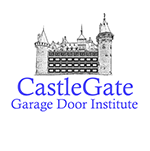These are some of the most common questions customers ask me about their garage door system. Check it out, it could save you a small fortune:
A: Usually, it is because your garage door has a broken spring, which looks something like this:

If you disconnect the door from the opener (usually achieved by pulling straight down on a red cord that is hanging from the opener trolley when the door is on the ground), it will feel very heavy. This is because the spring counterbalances your garage door, essentially providing the power needed to make it feel light when operated by hand.
A: 90% (or more) of the time it is because there is a problem with the safety eyes. Most of the time they are simply out of alignment. Here is more information on garage door safety eyes.
A: Most likely, the force sensitivity safety setting is shutting the motor off. This could be due to a part that is wearing out (usually a gear, sprocket bearing, or trolley), or the door could be binding or have some other mechanical problem.
Here is a guide to troubleshooting common garage door opener problems.
A: Most companies charge a minimum service charge of at least $80 to have a look at your door, and this fee may cover some minor adjustments or lubrication. However, if there is a failed part that needs replacement, you are probably going to total up somewhere between $150 and $300. Here is a list of what I charge for common repairs and services.
A: That depends on what the problem is. Many of the most common problems (e.g. safety eye repair/replacement, programming remotes, hinge replacement) can easily be done by most homeowners. Even bigger jobs like new opener installations and spring replacement are within the realm of possibility.
All garage doors have cables, springs, and other parts that are under extreme tension and have the potential to inflict serious injury if not handled properly. As long as you follow some basic safety precautions the danger is eliminated. Be sure to educate yourself before taking anything apart.
A: The Clicker brand universal remote will work for pretty much any Liftmaster, Chamberlain, Sears/Craftsman, Genie, Overhead Door Code Dodger, and Linear brand openers. It works with both “learn” button rolling code openers and older “dip switch” models. If you own a Wayne Dalton Quantum, Marantec, Sommer, Horman, or other less common brand, you will most likely need to find an exact match for your old remote.
This guide will help you find the right remote.
A: Again, Clicker makes a universal keypad that works for all of the same openers as the universal remote. However, you may loose some of the extra functionality that would come with the one from the manufacturer of your opener.
A: For most standard looking residential garage doors, 1/2 h.p. is adequate, assuming the door is properly balanced and operates smoothly. This is true for most doors up to 16 x 8.
If you have a “carriage style” door, full view glass panels, or the sections on the door measure taller than 21″ (big sections naturally lead to “clunky” operation), you may think about moving up to a 3/4 h.p. motor.
A recent trend from the major manufacturers is to only offer their top of the line openers in 3/4 h.p. (which is equivalent to 800 Newtons when talking about D/C motors that are common in the better models).
